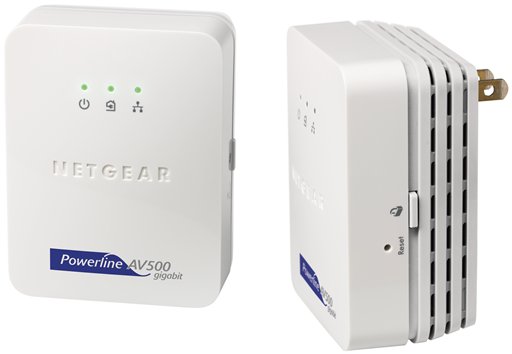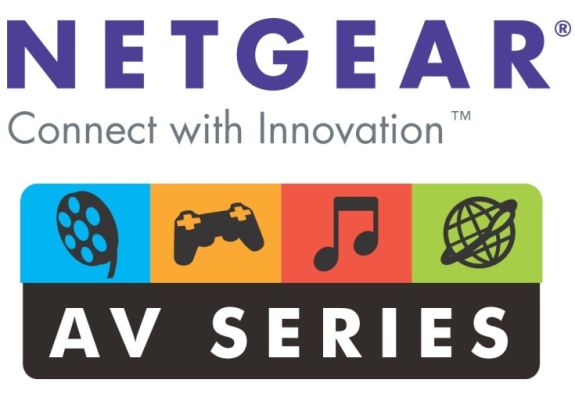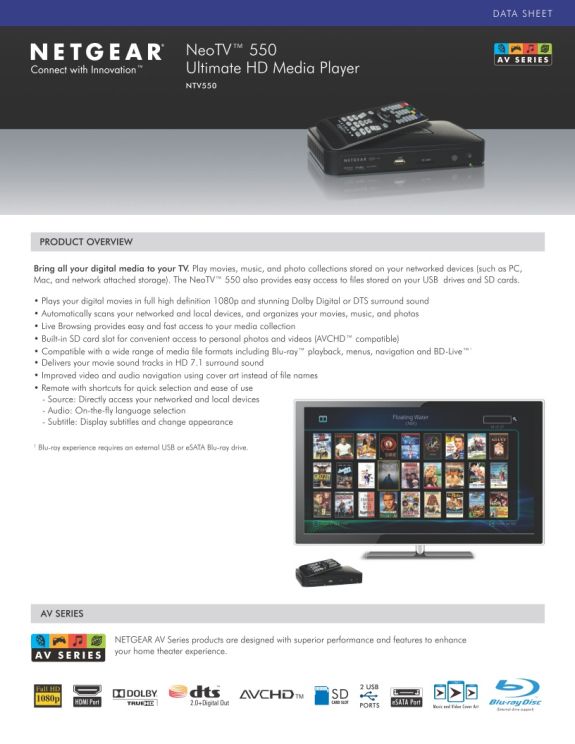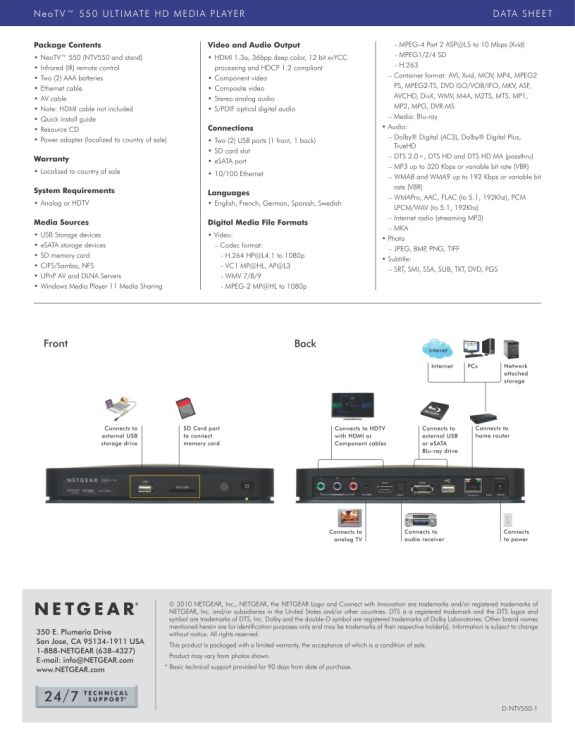Netgear AV Series Set for Expansion
by Ganesh T S on August 25, 2010 4:30 AM ESTThe first half of 2010 saw Netgear get started on their AV Series product line. Their intent was to create a set of products to enhance the consumer's home theater experience. The first few products appeared to be just rebranded versions of already existing units. A case in point is the WNDR3700 802.11n Gigabit router which was rebadged as the WNDR37AV a couple of months back. Rebadged products never generate much enthusiasm, even though Netgear may claim them to be designed with superior performance and features aimed at the home theater market. With Netgear's strength in the networking space, it is no surprise that all the products announced in the AV series so far have been aimed at making sure that the components of a home theater can talk in a satisfactory manner with the Internet, as well as the other components in the home network. However, can any home theater product line ever be complete without a media streamer? Is there any networking methodology (short of running Cat6 cables all over the house) reliable enough for streaming the highest quality Blu-Ray videos?
All this is set to change in the coming months, though. Netgear is slated to bring out a slew of press releases for the upcoming products towards the end of August 2010. In typical AnandTech fashion, we have the official scoop on the details which you are unlikely to find in the press releases.
NeoTV is slated to fill the missing media streamer space in Netgear's AV Series cupboard. Two models are planned, the NTV350 and NTV550. The US market will only see the NTV550, while the European and Australian markets will see both the NTV350 and NTV550. The NTV350 model meant for the non-US market has the same internal feature specifications as that of the WDTV Live (the remote is the same). It is apparently based on a Realtek chipset [Update: Netgear just confirmed that it is based on the RTL 1073]. In this news piece, we will talk about the NTV 550 in detail. The manufacturer's description is provided in the two scans below, for your initial perusal.
In order to differentiate itself from the rest of the media streamers in the market, Netgear has taken the extra step to obtain a license from the Blu-Ray consortium. As far as we know, this is the first media streamer at its price point to get this licensing. This implies that the unit can provide the full Blu-Ray experience, while retaining most of the functionality that the other media streamers provide. The Blu-Ray license comes with a price penalty for the consumer, but we will deal with that later in the piece. After a look at the product brief, AnandTech prepared the usual list of questions that a media streamer enthusiast would have wanted to clarify with Netgear. Some of the details we unearthed are given below:
- The Blu-Ray license guarantees the customer with HD audio passthrough as well as downmix (for Dolby TrueHD, Dolby Digital Plus, DTS-HD MA and DTS-HD HR). There is full support for Blu-Ray-ISO and DVD-ISO (inclusive of menus)
- Netflix will not be supported at the time of release, but it may come as a future firmware upgrade (no guarantees)
- Cover art generation with scraping is supported with a media management software bundled in the accompanying CD
- NFS support exists, but there is currently no plan to put tools in the CD to create NFS shares on a Windows PC
- Netgear has been made aware of the need for commitment to firmware development when dealing with support for the vaguely spec-ed MKV container. 'Advanced' MKV features such as HD audio and PGS subtitle streams are currently being investigated to ensure proper implementation in time for the release.
- The internal chipset has been confirmed to be Sigma Designs 8642 (that was no surprise once we learnt that Netgear had obtained a Blu-Ray license)
The NTV550 is expected to be available for purchase in October 2010 and will be sold at a suggested retail price of US $219.99 (we would really like it to be at a $199.99 price point). Media streamers at comparable prices bring in a slot for an internal hard drive and/or built-in Wireless-N support. The NTV550 has neither, but the Blu-Ray license accounts for the missing features, while maintaining the cost. If you have any further questions prior to the product release, feel free to put them in the comments, and we will get the answers for you.
The other exciting product we are looking forward to is the Powerline AV 500 Adapter Kit (XAVB5001). It was announced at the 2010 CeBit, but we are closer to shipping now, and have more details about the internal chipset.

Just yesterday, we talked about the Atheros 7400 chipset in the review of the WD Livewire, and now we have official confirmation that the AR7400 is indeed powering the whole Netgear AV 500 powerline product line. Netgear was the first to use Intellon's 6400/1400 chipset with the 200 Mbps PHY, and they now seem to have got first dibs with the 7400 chipset also. Netgear claims that the 500 Mbps PHY is getting them 200 - 250 Mbps in the labs. This should result in a real world throughput of at least 100 Mbps. This is more than enough for reliable streaming of a single Blu-Ray stream at its maximum specified bitrate of 54 Mbps (Wouldn't it be nice to see HomePlug AV's claim of being 'HD streaming capable' come true at last?). The Powerline AV 500 Kit (XAVB5001) is slated to hit shelves in late October for a suggested retail price of US $159.
AnandTech will receive the review units in October, and as usual, you can look forward to a really thorough review. If you would like to see anything tested in particular in the media streamer reviews or the powerline adapter reviews, do let us know in your comments. We will definitely revamp our powerline adapter benchmarking methodology, as it is not often that one gets to test out a new generation product in this space.













27 Comments
View All Comments
probedb - Wednesday, August 25, 2010 - link
...and there I was about to buy a Play!ON HD mini. I hope you guys do a really good review of media streamers once this comes out.Frequent firmware updates are definitely a required feature for these. IMO WD fail because they're very bad with updates.
Decaff - Wednesday, August 25, 2010 - link
I actually just bought a Playon! HD mini, and so far it has been really great. A little more tweaking of the firmware and I think it will be absolutely perfect (for me at least).Though had I seen this one was coming up, I too would probably have waited as well
buhusky - Wednesday, August 25, 2010 - link
no gigabit = not getting my money for a media/blu-ray iso streaming device. how are companies still making 10/100 devices still? is gigabit that much more expensive to put in?ganeshts - Wednesday, August 25, 2010 - link
There is a thread on AVSForums showing Popbox (using SMP 8643) with a 10/100 port streaming Blu-Ray ISOs without any issues from a NAS.In my opinion, it is the implementation of the networking stack and the host processor speed which matters. I think the NTV550 will pass the test, but can confirm only after the review.
Taft12 - Wednesday, August 25, 2010 - link
Agreed - the only Fail is the original posts understanding of technology.Gigabit ethernet triggers A LOT of interrupts regardless of whether the bus is PCI or PCI-E. This just doesn't make sense on small devices without the horsepower of a PC. As ganeshts has told us, a Blu-Ray ISO can be streamed over 100Mbit - I can't think of a more network intensive task you can ask of a media player than that!
Jaybus - Wednesday, August 25, 2010 - link
Not necessarily. With GigE also comes jumbo frames, reducing the number of interrupts. Also, 9k frame sizes are better suited to sequential streaming of large files.That said, 100 Mbps is fast enough to move a 4 GB file (ie. 2 hour MPEG2 DVD movie) in about 7 minutes. Far faster than is needed for streaming / playing files from an NFS share. Even Blu-Ray only requires 54 Mbps.
So, the only other aspect, really, is transferring files to a HD connected to the media device. I have had a Iomega HD device with GigE for a while. Yes, GigE is faster than 10/100, but it is still far too slow, and WLAN is agonizingly slow. When I just want to transfer files to the Iomega's hard drive, I find it far simpler and faster to move it to my PC and plug it into USB. The Netgear has eSATA, meaning I would never use NFS other than for streaming. Far faster to move an eSATA drive back and forth physically for transferring files.
CrapONez - Wednesday, August 25, 2010 - link
I just bought the Viewsonic NexTV VMP75 and moved my Netgear Homeplug HDX101 from my daughter's room to my living room. I'm getting FAR less bandwidth there than I was in her room (less than half). Too little to stream HD reliably (30-50Mbps). The other outlet plug goes to my power conditioner into which all my devices (including a 50" plasma) are plugged into.I connected a TB external drive via eSata to the VMP75 and it plays HD beautifully. Unfortunately I only get ~5Mbps transfer rates when copying files to it from an XP machine. I noticed at one point this went up to 15Mbps when all the A/V components were off. Does the power draw on the Homeplug's twin outlet affect throughput? I've been thinking of trying to move it to a different outlet.
I tried running Ethernet in the house... bought a fish tape and 500' of cat5e cable with connectors and all, climbed up into the attic heat of a Florida home with roofing nails clawing at my every move, and gave up when I realized that there were cross-braces between joists in the wall impeding my efforts.
The Homeplug has been great and effortless and worth the price. If only I could get the throughput I was getting in the other room. The computer room and my daughter's bedroom are on one side of the house and the entertainment system is on the other. Could that be why?
markk2 - Wednesday, August 25, 2010 - link
CrapONez,Plugging into power conditioners and a UPS was my problem with the Netgear stuff. I was getting round 25Mbps until I did some research and started plugging directly into the wall outlets. Now I always get 180-200Mbps at all three points in a two story 3000 sq ft house. Let us know if that works for you.
CrapONez - Wednesday, August 25, 2010 - link
Sorry if I was vague. I'm plugged directly into the wall at both ends. My AV power conditioner is plugged into the other receptacle of the same outlet. I was wondering if the power draw from it might affect my throughput or if it's simply because it's in a different part of the house (different side of the panel or longer run). thx!CrapONez - Thursday, August 26, 2010 - link
I tried an alternate outlet and immediately the Tx and Rx rates reported by the HDX101 configuration utility jumped to over 100Mbps. I thought I had a solution. But over the next few minutes, those numbers came down to around 50Mbps. (WTF?) That was last evening. Now they're hovering around 60Mbps. The "Quality" reading has jumped from "Data" to "DVD Video", but still a far cry from "HD Video". Any ideas why the initial reading was so high and then degraded from there?At least turning on the AV equipment doesn't affect throughput anymore.